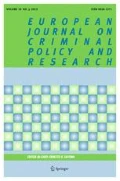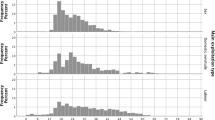Abstract
Trafficking in persons is a crime that poses exceptional challenges when it comes to measurement. For this reason, the literature on trafficking has only recently developed a set mass of quantitative estimates, although this remains insufficient to conduct studies at an international level. This lack of data has limited the possibility for quantitative studies and in particular the development of statistical models. Statistical models are extensively used in other social sciences to identify determinants that may increase or reduce the severity of a social phenomenon. This paper suggests the use of official administrative statistics on detected victims of trafficking in persons to develop quantitative models on human trafficking flows. The methodological approach suggested in this paper allows for identifying the factors explaining why certain countries—and not others—are relevant origins of trafficking flows into selected destination countries. These factors are found to be geographical distance to selected destinations, population size and level of organised crime. This result is in line with the few other quantitative studies on the determinants of trafficking, mainly framed in static gravity models. In addition, this paper proposes a dynamic approach to the determinants of trafficking flows. Trafficking flows change over time, and the relevance of certain places of origin may increase or decrease according to certain factors. This study flags variations in unemployment and national wealth in countries of origin as two factors affecting outflows of human trafficking.




Similar content being viewed by others
Notes
Article 3, paragraph (a) of the United Nations Protocol to Prevent, Suppress and Punish Trafficking in Persons (henceforth, UN Trafficking in Persons Protocol) defines trafficking in persons as the recruitment, transportation, transfer, harbouring or receipt of persons, by means of the threat or use of force or other forms of coercion, of abduction, of fraud, of deception, of the abuse of power or of a position of vulnerability or of the giving or receiving of payments or benefits to achieve the consent of a person having control over another person, for the purpose of exploitation. Exploitation shall include, at a minimum, the exploitation of the prostitution of others or other forms of sexual exploitation, forced labour or services, slavery or practices similar to slavery, servitude or the removal of organs.
Both countries define trafficking in persons according to Article 3 of the UN Trafficking in Persons Protocol.
For the purposes of this paper, the population data were collected from the World Bank, using different sources: (1) United Nations Population Division. World Population Prospects: 2017 Revision; (2) Census reports and other statistical publications from national statistical offices; (3) Eurostat: Demographic Statistics; (4) United Nations Statistical Division. Population and Vital Statistics Report (for various years); (5) US Census Bureau: International Database; and (6) Secretariat of the Pacific Community: Statistics and Demography Programme. https://data.worldbank.org/indicator/SL.UEM.TOTL.NE.ZS
For this paper, an alternative approach is used. Two organised crime indicators are selected. First, the World Economic Forum measures the perceptions of business communities on the level of organised crime in their countries (Schwab 2013). The second indicator makes use of the World Economic Forum indicator in combination with some objective indicators, such as unsolved homicides (Van Dijk 2008). The ranking resulting from these two variables appears to be reasonable, and, in the absence of better indicators, these variables are alternatively used as independent variables on the data concerning trafficking flows.
In her study, Cho (2015) suggests the variables ‘crime’ and ‘organised crime’ as determinants of trafficking in persons for both origin and destination countries. To measure organised crime, Cho refers to drug seizures recorded in different countries. By contrast, Hernandez and Rudolph (2015) make use of homicide rates. While the former study finds a relation between crime and trafficking flows, the latter does not.
The data concerning the citizenship of trafficked victims detected in the Netherlands were published by CoMensha in its different reports for the years 2010 to 2016. The data concerning Germany were published by the German Federal Police, the Bundeskriminalamt (2016) Menschenhandel Bundeslagebild, for the years 2010 to 2016. The US data were published by UNODC (2016b).
LnNedVict: natural logarithm of the number of victims of trafficking detected in the Netherlands in the years 2010–2014, aggregated by the citizenships of the victims
LnGerVict: natural logarithm of the number of victims of trafficking detected in Germany in the years 2010–2015, aggregated by the citizenships of the victims
LnUSAVict: natural logarithm of the number of victims of trafficking detected in the USA in the years 2010–2014, aggregated by the citizenships of the victims
LnDistNed: natural logarithm of the geographical distance by air between the geographical centre of the origin country and the geographical centre of the Netherlands
LnDistGer: natural logarithm of the geographical distance by air between the geographical centre of the origin country and the geographical centre of Germany
LnDistUSA: natural logarithm of the geographical distance by air between the geographical centre of the origin country and the geographical centre of the USA
LnPOP: population of the country.
LnCoci: natural logarithm of the Composite Organised Crime Index
LnWEF: natural logarithm of the World Economic Forum-organised crime perception index referring to the year 2013
The data referring to GDP per capita come from the World Bank. https://data.worldbank.org/indicator/NY.GDP.PCAP.CD?year_high_desc=true
The data referring to total unemployment (percentage of total labour force) in Hungary are published by the World Bank, using the International Labour Organisation, ILOSTAT database.
References
Andreas, P., & Greenhill, K. M. (2010). Sex, drugs and body counts: The politics of numbers in global crime and conflict. Ithaca and London: Cornell University Press.
Belser, P., De Cock, M., & Mehran, F. (2005). Minimum estimate of forced labour in the world. Geneva: International Labour Office.
Brunner, J. (2015). Inaccurate numbers, inadequate policies: Enhancing data to evaluate the prevalence of human trafficking in ASEAN. Honolulu: East-West Center.
Brunovskis, A., & Tyldum, G. (2004). Crossing borders: An empirical study of transnational prostitution and trafficking in human beings. FaFo report 426. Oslo.
Bundeskriminalamt. (2016). Menschenhandel Bundeslagebild 2016. Wiesbaden: Bundeskriminalamt.
Bureau NRM. (2002). Trafficking in human beings: First report of the Dutch national rapporteur. The Hague.
Cho, S. Y. (2015). Modeling for determinants of human trafficking: An empirical analysis. Social Inclusion, 3, 2–21.
Comensha. (2014). Menshenhandel in Nederland, Het beeld van 2014. Amersfoort: Comensha.
Comensha. (2016). Menshenhandel in Nederland, Het beeld van 2016. Amersfoort: Comensha.
Dank, M., Khan, B., Mitchell Downey, P., Kotonias, C., Mayer, D., Owens, C., Pacifici, L., & Yu, L. (2014). Estimating the size and structure of the underground commercial sex economy in eight major US cities. Research Report March 2014, The Urban Institute, pp 16–20.
Gould, A. J. (2010). From pseudoscience to protoscience: Estimating human trafficking and modern forms of slavery. Second Annual Interdisciplinary Conference on Human Trafficking 2010.
Gozdziak, E. M., & Collett, E. A. (2005). Research on human trafficking in North America: A review of literature. International Journal of Migration, 43(1/2), 99–128.
Hagan, F. E. (2005). Research methods in criminal justice and criminology (7th ed.). Allyn & Bacon.
Haynes, K. E., & Fotheringham, A. S. (1984). Gravity and spatial interaction models. Sage Publications.
Hernandez, D., & Rudolph, A. (2015). Modern day slavery: What drives human trafficking in Europe? European Journal of Political Economy, 38, 118–139.
Jiang, B., & LaFree, G. (2017). Social control, trade openness and human trafficking. Journal of Quantitative Criminology, 33(4), 887–913.
Merry, S. E. (2016). The seductions of quantifications, measuring human rights, gender violence and sex trafficking. Chicago and London: The University of Chicago Press.
Pitts, W. J., Barrick, K., Zhang, S., & Lattimore, P. K. (2015). Estimating labor trafficking among farmworkers: An inverse sampling strategy based on reliable housing predictions. Journal of Human Trafficking, 1(2), 117–135.
Schwab, K. (2013). The global competitiveness report 2013–2014. Geneva: World Economic Forum.
Silverman, B. (2014). Modern slavery: An application of multiple systems estimation. London: Home Office.
Steinfatt, T. M. (2003). Measuring the number of trafficked women and children in Cambodia: A direct observation field study, part III.
Steinfatt, T. M., & Baker, S. (2008). Measuring the extent of sex trafficking in Cambodia: 2008. Bangkok: United Nations Inter-Agency Project on Human Trafficking, Bangkok, 2011.
Steinfatt, T. M., Baker, S., & Beesey, A. (2002). Measuring the number of trafficked women in Cambodia 2002; part I. Globalization Research Center – University of Hawaii-Manoa Honolulu, Hawaii USA, 13–15 November, 2002.
Stewart, J. Q. (1941). An inverse distance variation for certain social influences. Science, 93, 89–90.
United Nations Office on Drugs and Crime. (2020). How COVID-19 restrictions and the economic consequences are likely to impact migrant smuggling and cross-border trafficking in persons to Europe and North America, UNODC, Research Brief.
United Nations Office on Drug and Crime (UNODC). (2006). Trafficking in persons: Global patterns 2006. Vienna: UNODC.
United Nations Office on Drug and Crime (UNODC). (2012). Global report on trafficking in persons 2012. Vienna: UNODC.
United Nations Office on Drug and Crime (UNODC). (2014). Global report on trafficking in persons 2014. Vienna: UNODC.
United Nations Office on Drug and Crime (UNODC). (2016a). Multiple systems estimation for estimating the number of victims of human trafficking across the world. Vienna: UNODC.
United Nations Office on Drug and Crime (UNODC). (2016b). Global report on trafficking in persons 2016. Vienna: UNODC.
United Nations Office on Drug and Crime (UNODC). (2018). Global report on trafficking in persons 2018. Vienna: UNODC.
United States Department of State. (2001). Trafficking in persons report 2001. Washington, D.C.: United States Department of State.
United States Department of State. (2002). Trafficking in persons report 2002. Washington, D.C.: United States Department of State.
Van Dijk, J. (2008). The world of crime: Breaking the silence of problems of security, justice, and development across the world. Los Angeles: Sage Publications.
Walk Free Foundation (WFF). (2013). The global slavery index 2013. WFF.
Walk Free Foundation (WFF). (2014). The global slavery index 2014. WFF.
Walk Free Foundation (WFF). (2016). The global slavery index 2016. WFF.
Zhang, S., & Li, C. (2015). Counting labour trafficking activities: An empirical attempt at standardized measurement (p. 8). Forum on Crime & Society.
Zhang, S., Spiller, M. W., Finch, B. K., & Qin, Y. (2014). Estimating labor trafficking among unauthorized migrant workers in San Diego. Annals of the American Academy of Political and Social Science, 653(1), 65–86.
Acknowledgments
The author is grateful to Ms. Angela Me, chief of the UNODC Research and Analysis Branch, for guiding the whole UNODC research activity, including the production of the different editions of the Global Report. The author wishes to express gratitude to Ms. Kristiina Kangaspunta, chief of the UNODC Crime Research Section, for guiding the research work on trafficking in persons and the different members of the UNODC Research Team on Trafficking in Persons and Smuggling of Migrants who over the years contributed to the different editions of the Global Report.
This paper would not have been possible without the guidance, the work and the perseverance of these UNODC staff members.
Author information
Authors and Affiliations
Corresponding author
Additional information
Publisher’s Note
Springer Nature remains neutral with regard to jurisdictional claims in published maps and institutional affiliations.
The views expressed herein are those of the author(s) and do not necessarily reflect the views of the United Nations.
Appendix
Appendix
Rights and permissions
About this article
Cite this article
Sarrica, F. The Use of Human Trafficking Detection Data for Modelling Static and Dynamic Determinants of Human Trafficking Flows. Eur J Crim Policy Res 28, 483–501 (2022). https://doi.org/10.1007/s10610-020-09460-5
Published:
Issue Date:
DOI: https://doi.org/10.1007/s10610-020-09460-5




